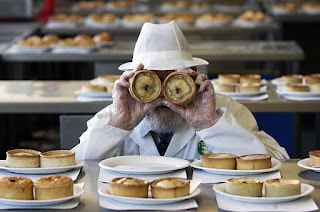Kenya was in a state of war with their neighboring country, Uganda, until this unfortunate incident happened with Indeo Nahale stuck in the middle of a cop chase.

On May 4, 1979, Galven Avery was in his bakery when he saw a little child walk into the bakery so he wanted to make a good impression so he put his pastries up to his eyes, to be silly.
Mr. Avery has owned his store for over 25 years and this was the first time anyone had ever seen him be as childish as he was that day.
2.
1. Rule of thirds- a rule of thirds is when the photographer uses the grid on the camera screen to position the subjects on the corners of that grid.
2. Balancing Elements- this is where the photographer makes sure there are equal amounts of the subject in the photo so they don't look like there unbalanced.
3. Leading Lines- this is where the photographer uses lines to direct the viewer's eye to the subject.
4. Symmetry and Patterns (repetition)- this is when there is a repeated theme throughout the photo, or where there is an equal amount of the same thing on one side of the image.
5. Viewpoint- viewpoint is the angle that the photographer is looking at the subject when they take the picture.
6. Background- Using different backgrounds in the image can hide or bring out the effectiveness of the subject.
7. Create depth- this is when the photographer sets the photo up so that it gives a sense of 3 dimensions and not just 2.
8. Framing- this is when the subject is framed by something that they are being surrounded by in their location.
9. Cropping- Is when you get closer to the subject so that there is less background to disrupt the subject.
10. Mergers and avoiding them- a merger is when the photograph has a person or thing that is partially cut out and we try to avoid these because it is not appealing to look at.
3.
- aperture is the size of the opening of the lens in the camera limiting the amount of light that can get in at any time.
- Shutter speed is how fast the shutter closes which also limits the amount of light that can come in. The slower the speed, the larger amount of light received.
- ISO is the sensitivity to light that the camera experiences. The lower the number, the less sensitive it is to light.
4.
Changing a person's face and body in any way aren't right, but cropping and adding light exposure are okay.
5.
- An environmental portrait is where the subject is in a good place that resembles who they are or what they do.
- A formal portrait is where the subject is dressed nicely and is looking directly at the camera.
- an informal portrait is where the subject is not looking at the camera and is doing something else.

No comments:
Post a Comment